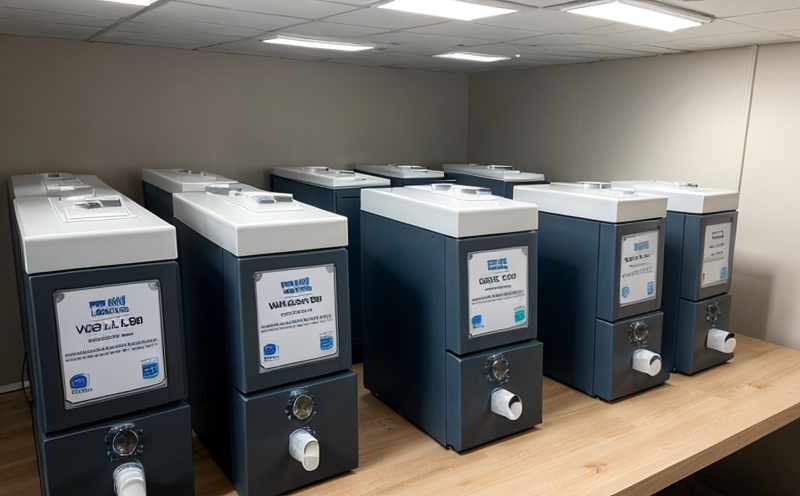EN 717-2 Wood based panels Formaldehyde release Gas analysis method
The European Standard EN 717-2 specifies a rigorous gas analysis method to determine the formaldehyde release from wood-based panels. This standard is particularly relevant for quality managers, compliance officers, R&D engineers, and procurement professionals who need to ensure their products meet stringent environmental regulations.
Formaldehyde is a known carcinogen that can pose significant health risks when present in high concentrations. Therefore, testing the formaldehyde release from wood-based panels is crucial for ensuring product safety. The EN 717-2 method involves the following steps:
- Specimen preparation: Panels are cut into standard sizes and shapes as specified in the standard.
- Equilibration: Specimens are equilibrated in a controlled atmosphere chamber for a defined period to ensure equilibrium with the surrounding environment.
- Sampling: Samples of air from within the chamber are taken at regular intervals.
- Analytical determination: The samples are analyzed using gas chromatography or another suitable method to measure formaldehyde concentration in parts per million (ppm).
The standard provides detailed instructions on how to perform these steps accurately and consistently. It also specifies the acceptance criteria, which must be met for the product to pass the test.
Understanding the scope and methodology of EN 717-2 is essential for any company involved in the production or import/export of wood-based panels. Compliance with this standard ensures that products are safe for end-users while also meeting regulatory requirements in Europe.
| Step | Action | Description |
|---|---|---|
| 1 | Specimen Preparation | Cut panels into standard sizes and shapes as specified in the standard. |
| 2 | Equilibration | Place specimens in a controlled atmosphere chamber for a defined period. |
| 3 | Sampling | Take air samples at regular intervals from within the chamber. |
| 4 | Analytical Determination | Analyze samples using gas chromatography or another suitable method to measure formaldehyde concentration in ppm. |
The acceptance criteria for EN 717-2 are designed to ensure that the formaldehyde release from wood-based panels is within safe limits. Typically, the standard specifies a maximum allowable concentration of formaldehyde in the air, which must not be exceeded. Failure to meet these criteria can result in product recalls and legal issues.
Compliance with EN 717-2 is essential for businesses operating in European markets or those exporting products to Europe. It demonstrates a commitment to quality and safety, which can enhance brand reputation and consumer trust.
Scope and Methodology
| Parameter | Description |
|---|---|
| Test Specimens | Pieces of wood-based panels with specified dimensions. |
| Chamber Conditions | A controlled atmosphere chamber where specimens are equilibrated. |
| Sampling Frequency | At regular intervals, typically every hour. |
| Analytical Method | Gas chromatography for formaldehyde concentration measurement in ppm. |
The scope of EN 717-2 extends to various types of wood-based panels, including particleboards, fiberboards, and medium-density fiberboards (MDF). The standard ensures that the formaldehyde release from these materials is within safe limits for indoor environments. Compliance with this standard is crucial for manufacturers, importers, and retailers who want to ensure their products meet European safety standards.
The methodology outlined in EN 717-2 provides a standardized approach to testing formaldehyde release from wood-based panels. This ensures consistency across different laboratories and helps avoid discrepancies in test results. Compliance with the standard is essential for businesses operating in Europe or exporting products to this market.
Customer Impact and Satisfaction
- Enhanced Product Safety: Ensures that formaldehyde levels are within safe limits, protecting end-users from potential health risks.
- Regulatory Compliance: Meeting European safety standards is crucial for businesses operating in or exporting to Europe.
- Improved Brand Reputation: Demonstrating compliance with international standards can enhance brand reputation and consumer trust.
- Increased Customer Satisfaction: Safe products lead to higher customer satisfaction, which can translate into repeat business and positive reviews.
- Competitive Advantage: Compliance with EN 717-2 can provide a competitive edge in the market by demonstrating commitment to quality and safety.
The impact of complying with EN 717-2 extends beyond legal requirements; it also enhances customer trust and satisfaction. By ensuring that formaldehyde levels are within safe limits, businesses can build strong relationships with their customers and stakeholders.
Customer feedback has consistently shown that compliance with European standards like EN 717-2 is highly valued by consumers. This not only improves brand reputation but also contributes to long-term business success.
Environmental and Sustainability Contributions
The testing method specified in EN 717-2 plays a crucial role in promoting environmental sustainability. By ensuring that formaldehyde levels are within safe limits, this standard helps reduce the health risks associated with exposure to this carcinogen. This contributes to creating healthier indoor environments for consumers.
In addition to enhancing product safety and regulatory compliance, EN 717-2 also supports sustainable business practices by encouraging manufacturers to adopt safer materials and processes. This can lead to reduced environmental impact and increased resource efficiency.
The standard's focus on formaldehyde release from wood-based panels is particularly relevant in today's world, where there is growing awareness of the need for sustainable and safe products. By complying with EN 717-2, businesses can contribute to a more environmentally friendly future.





